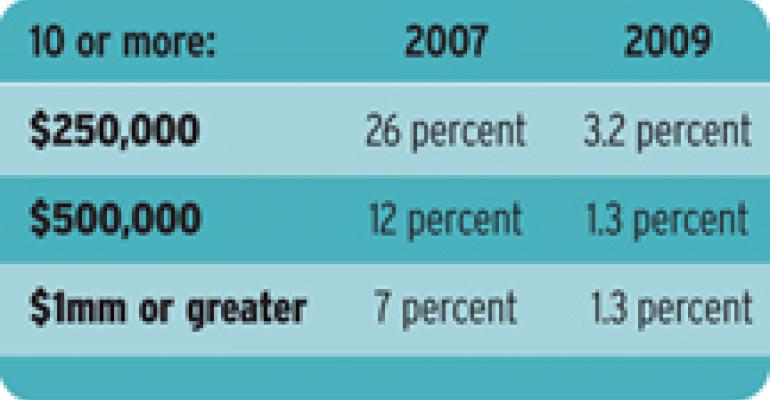A little over two years ago, when analyzing our research on affluent client acquisition, one of our statisticians — those PhDs who make certain that our data is statistically meaningful but know little about how the business of financial services works — made a salient comment: “This industry is in trouble.”
I wish I could tell you that he foresaw the current meltdown in the markets and the economy, but he didn't. He was focused on what the data was telling him about financial advisors who serve the affluent. This data measured the percentage of advisors who were annually bringing in 10 or more new clients with $1 million or more in assets — the very definition of a Rainmaker. Back then, he thought the industry was in trouble because the data suggested that financial advisors were doing a dismal job of selling their services to the affluent.

Now, in the midst of the greatest financial crisis of our lifetime, the industry really is in deep trouble, and advisors' are having even worse luck. A quick glance at the trend line from our 2007 and first quarter 2009 affluent client acquisition findings tells the story (the figures here indicate the percentage of financial advisor respondents who brought in 10 or more clients in the previous 12 months):
Forget about rainmakers bringing in million-dollar-plus relationships — 97 percent of all financial professionals are not even bringing in new clients with at least $250,000 in assets to invest. This is a frightening indicator. If advisors don't start playing offense in a serious manner, there will simply be a lot less of them in the near future.
Now that I've got your attention, let me remind you that this is the perfect storm for Rainmaking. The affluent investor is beyond dissatisfied — many are disgusted. And not only with Wall Street, politicians, and regulators. Many are disgusted with their financial advisors.
How do you take advantage of it? First of all, it is essential for your sanity as well as the future of your business that you stop spending all day talking to existing clients. (This does not mean you stop paying attention to their needs, by any stretch. Just don't overdo it.) Whether you realize it or not, you are probably playing defense in the majority of these conversations. Even with clients who understand that you're not at fault, a twinge of guilt seeps into your psyche. Too much of this will zap the energy and enthusiasm of even the best advisors. The secret is to block out time every day for serving existing clients and allot another block of time, each day, for playing offense with prospective clients.
As a Rainmaker recently told me, “It was like I reaffirmed my value. I couldn't believe it. My two new clients weren't even getting return calls from their former advisors. Their comments to me were, ‘I don't care if you beat this guy's (their former FA) performance, I just want you to communicate to me and guide my family through this mess.’ It feels so good talking with clients of other advisors - when I'm Rainmaking I don't have to play defense and can take advantage of my competition's mistakes.”
Not only did this advisor land two new affluent clients, with portfolios worth $1.5mm and $2.3mm respectively, he understands the psychological importance of prospecting in today's environment. He's using his offense to keep his mojo on track.
For those cynics out there, listen carefully — I am not advocating that you neglect your clients. What I am strongly recommending is that every day you need to get out of your office, engage in conversations with prospective clients, apply your affluent sales skills, and aggressively go after new affluent relationships. After all, the prospecting stars are aligned.
Writer's BIO:
Matt Oechsli
is author of Building a Successful 21st Century Financial Practice: Attracting, Servicing & Retaining Affluent Clients.oechsli.com






